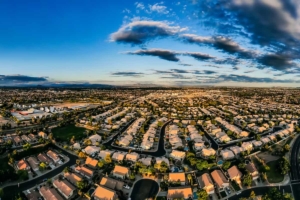Typical home values eclipsed $350,000 for the first time ever as healthy demand from buyers continues to collide with reluctant sellers, according to the latest Zillow Market Report.
LEARN MORE: Housing affordability rises across all Arizona metros
The June Zillow Home Value Index for Phoenix was $448,032, a month-over-month increase of 1% and a monthly mortgage payment of $2,307 with 20% down. That monthly mortgage payment is a 112.2 % increase over 2019.
“Home buyers have persisted this spring despite daunting affordability challenges and record-low inventory,” said Jeff Tucker, senior economist at Zillow. “Demand typically begins to ease in the summer, and there are signs that competition is waning, but large price declines are unlikely until more homeowners list their homes for sale.”
he typical U.S. home value climbed 1.4% from May to June, continuing a four-month hot streak. The new peak of $350,213 is almost 1% higher than last June and barely edges out the previous Zillow Home Value Index record set in July 2022.
From hot spots to soft spots: Local home value trends: Affordability remains the key to market strength, as lower-priced metro areas posted the largest monthly gains; Chicago, Buffalo, New Orleans and Hartford all notched 2.1% monthly growth, with Detroit close behind at 2%. Those markets all have typical home values lower than the national average.
As in May, home values rose from the previous month in all 50 of the largest metro areas. The slowest monthly growth was in Austin (0.4%), followed by Jacksonville, Memphis, San Antonio and Birmingham, which all saw 0.8% increases.
Drought of new listings intensifies: The flow of new homes for sale ticked up 2.4% month over month, but the annual deficit deepened, now standing at 28% fewer listings than a year ago. June is usually one of the best months for fresh inventory, but this year only 376,500 new listings arrived on the market. That’s closer to levels seen in the slower months of February and October than to average new listings in June (505,100), according to Zillow data reaching back to 2018.
A lack of new listings has dogged the housing market for nearly a year, and higher mortgage rates remain the chief suspect. Rates at 6.8% this week (the highest since November, up from 5.1% a year ago and 3% two years ago) make it especially costly for homeowners — most of whom have a mortgage well below today’s rates — to borrow for their next home purchase.
Another explanation could be that homeowners are holding out for higher prices. Home values have steadily increased since January in much of the country, but remain below peaks reached last summer in many markets.
“It could be that some homeowners have been waiting until prices set new highs in their market before opting to cash in their chips,” Tucker said.
The total pool of existing homes for sale is lower than any June since at least 2018. It’s down 10% from last year and a tremendous 45% below June 2019.
Drop-off in demand means less competition for buyers: Potential buyers could see some slight relief on the horizon, as a few metrics indicate demand and competition are cooling. Sales measured by newly pending listings dipped almost 5% from May to June, following seasonal trends seen in 2022 and before the pandemic, when accepted offers crested in May.
Listings also lasted longer in June, 11 days before the typical listing went pending, compared to 10 in May. But that’s still a much faster market than in 2019, when listings went pending in 21 days.
Rent growth is back to normal: Zillow’s latest monthly rent report shows rent growth is back to pre-pandemic norms for this time of year, about 0.6% per month. San Diego overtook San Francisco as the third-most-expensive place to rent.




